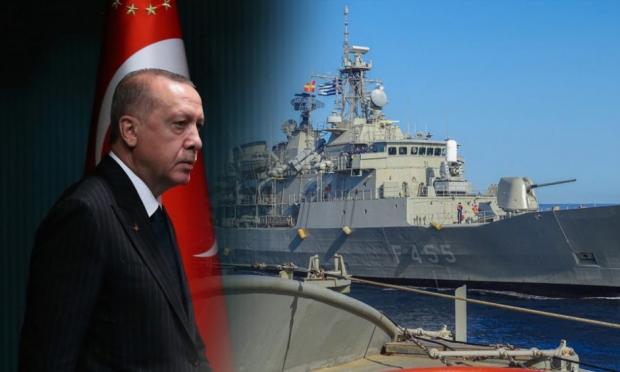With the searches continuing for the location in the area of Farmakonisi, Turkey not only challenged Greek jurisdiction but also illegally tied up an area between Agathonissi and Farmakonissi that includes the stigma given by Athens as the center of a research area with a range of 25 nautical miles within of the territorial waters included therein.
In particular, in the illegal NAVTEX 836019/23, the Turks report: "On March 11, 2023, 10 migrants were found in a rubber dinghy in the west of Aydin, Didim province. A search and rescue operation was carried out by the Turkish coast guard within the Turkish search and rescue area due to missing migrants. Sailing vessels are requested to be alert and report findings to the Turkish Coast Guard."
Search and Rescue in the Aegean
Aviation accident search and rescue is governed by Annex 12 of the 1944 Chicago Convention and ICAO Rules and Recommendations. The Greek area of responsibility for search and rescue, in cases of air accidents, has been defined by a regional air navigation agreement in the framework of the ICAO Conference in 1952 and coincides with the Athens FIR.
Regarding search and rescue in cases of maritime accidents, Greece has been coordinating these operations within the Athens FIR, since it was created in the 1950s. The assumption by Greece of responsibilities for maritime search and rescue within the Athens FIR reflects the geographical reality in the region, given the scattered Greek islands in the Aegean, which allow the most immediate, rapid and efficient, from an operational point of view, the provision of services for the protection of of human life at sea. After all, this is consistent with relevant recommendations of the IMO and the ICAO regarding the need for Search and Rescue areas, both for aviation and maritime accidents, to coincide with the limits of the FIRs.
In 1975, Greece declared its area of responsibility for maritime search and rescue in the Intergovernmental Maritime Consultative Organization (IMCO), predecessor of the International Maritime Organization (IMO). Also, both at the time of signing and ratifying the 1979 Hamburg Convention, which regulates matters of maritime search and rescue and was adopted within the framework of the IMO, Greece stated that its area of responsibility coincided with the Athens FIR, a statement that was also included in the law by which the said International Convention was incorporated into the Greek legal order in 1989 (Law 1844/1989).
It is noted that the Hamburg Convention provides that the areas of responsibility of the contracting parties for the provision of search and rescue services, in cases of maritime accidents, are determined by agreement of the coastal states concerned. In this context, Greece has signed Agreements for cooperation in matters of maritime search and rescue both with Italy (2000), as well as with Malta (2008) and Cyprus (2014), in which it is expressly defined that the Greek region in question responsibility coincides with the Athens FIR, while the signing of corresponding Agreements with the other neighboring states is also pending.
Nevertheless, in 1988, Turkey issued Regulation 1988/13559 (as amended by Regulation 2001/3275), by which it defined as its area of responsibility the provision of search and rescue services, without specifying whether it is naval or for air accidents, an area which, in addition to the Istanbul and Ankara FIRs, includes part of the Athens FIR up to about the middle of the Aegean, enclosing a large part of Greek territory within a Turkish search and rescue area. In October 2020, Turkey with its newest Regulation (3095/2020), which specifically refers to search and rescue for both maritime and air accidents, expanded its area of responsibility for search and rescue in the Mediterranean – within the Athens FIR – westwards until the 26th Meridian touching the external territorial waters of the eastern coasts of Crete, occupying a larger part of Greek territory (e.g. Kasos and Karpathos islands) and Greek search and rescue area.
This Turkish action, i.e. the inclusion of Greek islands, Greek territorial waters and Greek airspace in the Turkish search and rescue area clearly violates Greece's sovereignty and the relevant International Conventions.
And the inclusion of part of the Athens FIR in the Turkish area of responsibility, in addition to lacking operational efficiency, violates Greek powers assigned by the ICAO.
It also contradicts the general international practice, as well as the recommendations of the IMO and ICAO, included in the International Aeronautical and Maritime Search and Rescue Manual (IAMSAR Manual), which favor the adoption of identical areas for the provision of search and rescue services in maritime and aviation accidents. Similarly, annex 12 of the Chicago Convention recommends that search and rescue areas coincide with the boundaries of FIRs.
It becomes clear from the above that any Turkish objections in this case serve specific political purposes that have nothing to do with the humanitarian search and rescue operations. And the most recent (October 2020) expansion of the Turkish search and rescue area in the Eastern Mediterranean, so that it coincides with the boundaries of the new expansive Turkish narrative of the "Blue Homeland", demonstrates that Turkey uses search and rescue as another vehicle for promoting its revisionist and expansive views on maritime zones beyond any concept of international law.
In any case, it is noted that in practice, Greece, through the competent Greek Joint Rescue Coordination Center (JRCC) in Piraeus, effectively coordinates all search and rescue operations, providing services to all those at risk. ships and planes within the Greek area of responsibility.




